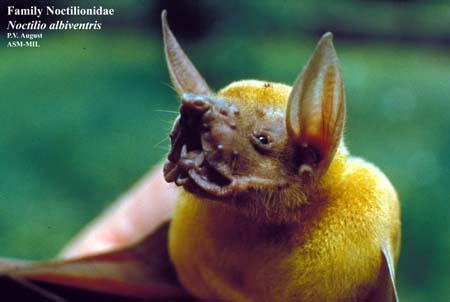Fishing Bulldog Bat
Fishing Bulldog Bat (Noctilio leporinus) Spanish Name: Murcielago Pescador

More about Fishing Bat
Habitat
These bats inhabit lowland areas on both coasts where there are rivers, pools, or other bodies of water (including salt water) calm enough to fish in.
Range
Between Sinaloa, Mexico and northern Argentina, these bats are usually below 200 m in elevation.
Physical Description
This large bat is found in areas where it can hunt over open, relatively still bodies of fresh or salt water. It is covered in short reddish brown to orange brown fur with a pale middorsal stripe; the fur color can change from ammonia fumes in the roost. This bat has characteristic, very long legs and enormous feet, both of which help it gaff fish from the water. It also has a bulldog-like face for which it is named, with narrow, pointed ears and very small eyes in a flat, puffy face. The wings on this bat are pointed and long even for its size-it may have developed wings this long because of the obstacle-free setting in which it forages. Also because of its diet, this bat has a strong fishy odor.
Biology and Natural History
The bulldog bat usually forages independently, but has been seen sometimes flying in pairs over the water. To catch fish, the bat skims close to the water's surface, sending out echolocation pulses; when it detects a ripple or a small object breaking the water's surface, it dips its feet into the water for a distance of 10 to 20 cm, and sometimes gaffs a small fish or other prey item with its large feet and claws.
Each foot sweeps a path 3 to 4 cm wide; if it snags a meal, it takes the prey into its mouth, and usually will pause from hunting to hang upside down somewhere and eat. If it keeps the fish in the mouth, emitting sonar waves is more difficult; so sometimes, the bat will partially chew the fish, push the meat into the cheek pouches on the wings, and continue fishing. The bat eats its prey entirely, crunching the bones in its powerful jaws.
These bats may repeatedly leave and return to the roost all night between fishing trips. During the day they roost in colonies that generally number 75 individuals, but may have hundreds. These roosts are sometimes in hollow trees or buildings, but they prefer caves and sometimes are found in sea caves. An adult female will have one pup each year, and within the roost the females may form nursery colonies.
Diet
The fishing bulldog bat mostly eats fish, but also will consume insects or small crustaceans picked from the water surface, as well as insects caught in the air. They have been known to also eat smaller amounts of scorpions, crabs, and terrestrial insects.
Height/Weight
Adult males are usually largest, with a head and body length averaging 96.9 cm and a weight of 67 g (they may weigh as much as 90 g); females are 91.3 cm long and weigh 56 g. These bats have a wingspan of 60 cm.
Taxonomy
Order: Chiroptera
Family: Noctilionidae
Sources
Brandon, C. in Janzen, Daniel H. Costa Rican Natural History. Chicago: University of Chicago Press, 1983.
Eisenberg, John. Mammals of the Neotropics, Vol. 1. The University of Chicago Press: Chicago, 1989.
Kricher, John. A Neotropical Companion: an introduction to the animals, plants, and ecosystems of the New World tropics. Princeton University Press: Princeton, NJ, 1997.
LaVal, Richard K. and Rodriguez-H., Bernal. Murcielagos de Costa Rica. Instituto Nacional de Biodiversidad, Costa Rica, 2002.
Wilson, D. E. in Janzen, Daniel H. Costa Rican Natural History. Chicago: University of Chicago Press, 1983.
Amy Strieter, Wildlife Writer
Fishing Bat Sightings
Similar Profiles
It's more than just having a good time or visiting beautiful places (although that's absolutely a part of it!), it's about being part of a unique experience that stays with you.



